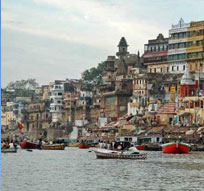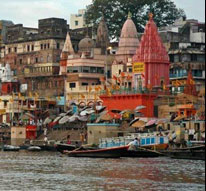Golden Temple, Amritsar is a place frequented by Sikhs all round the year. The pivot of Sikh community life, Golden Temple was envisioned by Guru Arjan. Siri Guru Arjan Dev reversed the prevalent practice of designing high temple plinths. By building the Harmandir at a level lower than the surrounding land, he wanted to emphasize the inner strength that was provided by the faith, rather than draw attention
to its external manifestations.
Countless pilgrims
visit Golden Temple to pay homage to the holy shrine. Golden Temple
is also known as Hari Mandir meaning Temple of God. The Temple has a
tank (Sarovar) that is believed to possess healing powers. Sikh
Gurus founded new centers for the promotion of Sikhism and these
centers became popular as Sikh pilgrimage sites. The temple's
architecture draws on both Hindu and Moslem artistic styles yet
represents a unique co-evolution of the two. During the reign of
Maharaja Ranjit Singh (1780-1839), Hari Mandir was richly ornamented
with marble sculptures, golden gilding, and large quantities of
precious stones. Within the sanctuary, on a jewel-studded platform,
lies the Adi Grantha, the sacred scripture of the Sikhs.
Sri
Harmandir Sahib, is built on a 67ft. square platform in the center
of the Sarovar (tank). It has a door each on the East, West, North
and South. The darshani deori (an arch) stands at the shore end of
the causeway. The door panes are decorated with artistic style. It
opens on to the causeway or bridge that leads to the main building
of Sri Harmandir Sahib. The bridge is connected with the 13 feet
wide 'Pardakshna' (circumbulatory path). It runs round the main
shrine and it leads to the 'Har ki Paure' (steps of God). On the
first floor of 'Har ki Paure', there is continuous reading of Guru
Granth Sahib.
The Golden Temple, as is stands today
with the luminous exterior plates with gold is chiefly the work of
Maharaja Ranjeet Singh. He took deep interest in getting the Temple
artistically decorated .He invited skilled architects, masons and
wood carvers from different part of the country. Yar Mohammad Khan
Mistri was the technical expert for gold plating carried out in
1830. The entire Gold leaf covering was changed in 2003, exactly 173
years after it was first put into place.
Architecture
of the Golden Temple Sri Harmandir Sahib is built on a 67ft. square
platform in the centre of the Sarovar (tank). The temple itself is
40.5 ft. Square. It has a door each on the East, West, North and
South. The Darshani Deori (an arch) stands at the shore end of the
causeway. The doorframe of the arch is about 10ft in height and 8ft
6inches in breath. The door panes are decorated with artistic style.
It opens on to the causeway or bridge that leads to the main
building of Sri Harmandir Sahib. It is 202 feet in length and 21
feet in width.
The bridge is connected with the 13
feet wide 'Pardakshna' (circumambulatory path). It runs round the
main shrine and it leads to the 'Har ki Paure' (steps of God). On
the first floor of 'Har ki Paure', there is continuous reading of
Guru Granth Sahib. The main structure of Sri Harmandir Sahib,
functionally as well as technically is a three-storied one. The
front, which faces the bridge, is decorated with repeated cusped
arches and the roof of the first floor is at the height of the 26
feet and 9 inches.
|









